Guest review by Niroot Puttapipat (Himmapaan)
Diplodocids are largely represented in figure form by the ubiquitous Apatosaurus (or ‘generic-o-pod’, as a certain friend and esteemed colleague has it), with Diplodocus itself being relatively few in number. I greeted the news of the CollectA model with mixed feelings; glad that there is another to add to the list, but afraid, quite prejudicially, that it might disappoint. Preview pictures did suggest an overall promising model, however, and so it proved.

The figure looks especially handsome in profile, its rearing posture lending it a graceful dynamism and, from my own purely personal aesthetic perspective, the most elegant set of shallow curves within an overall bow shape (I’m an illustrator, I can’t help seeing these things). Whether the larger sauropods were capable of rearing on their hind legs or not is still a matter for debate, but the posture actually looks convincing and not uncomfortable in this figure. Perhaps CollectA intended this as a nod (or a challenge?) towards that most beloved of Diplodocus figures, the Battat? Certainly the comparison is unavoidable.
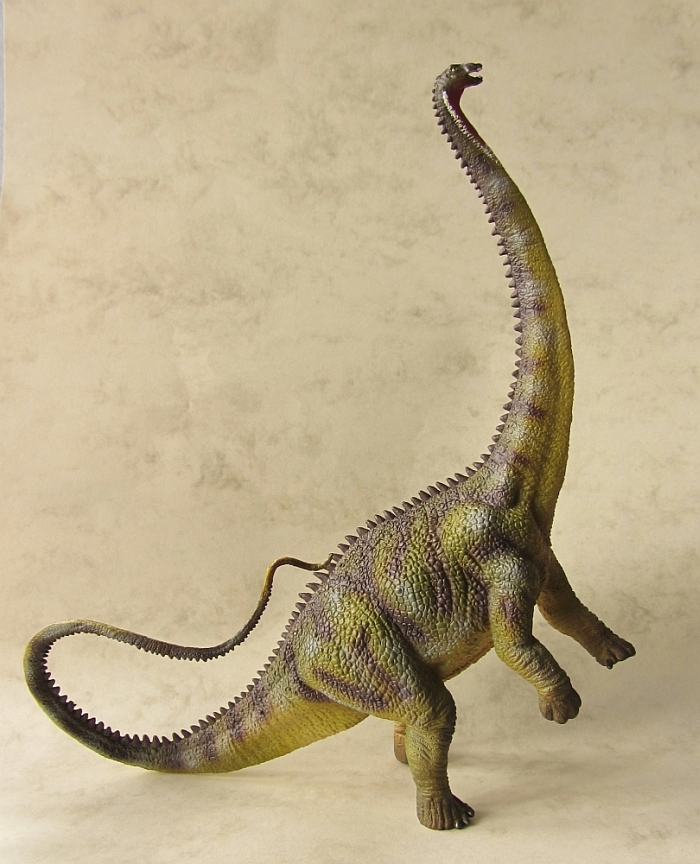
The overall proportions, to a non-expert like me, look almost perfect. The head is suitably small when it is often made too large in sauropod figures. The tail is thick at the base and tapers away beautifully towards the tip, producing as it does that characteristic whiplash curve; again, in a much more convincing way than the ribbon-like waves throughout the tail’s entire length one often sees.
Elephant feet in sauropods are perhaps equal to pronated hands in theropods: vexing, thoroughly wrong, and yet continually repeated by artists. Happily, this figure boasts correctly shaped hands with only the first claw on each, and three claws on the feet. I especially admire the way the latter are even turned slightly outwards to the side rather than pointing directly to the front.
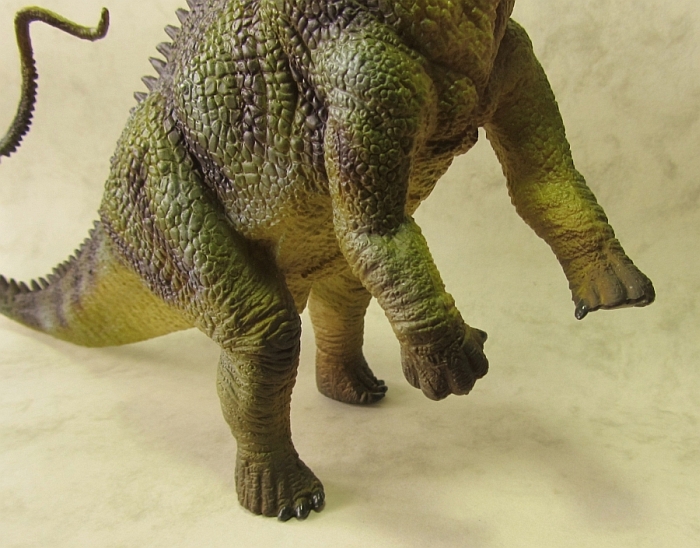
The gradated greens and brown stripes may not present the most novel of paint schemes, but they do strike a pleasant balance between the subdued and the vibrant in their subtly variegated application, with the red throat adding a good complementary hotspot.
But what of its negatives? Well, those laudable feet suddenly display a curious feature once you look beneath them and observe those sunken ‘pads’.
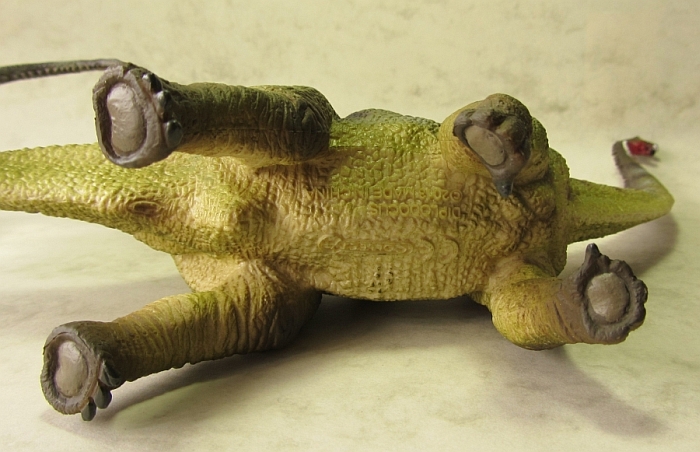
The appropriately tiny head still features what I can only describe as a goofy expression, and I’m not talking about its teeth; an aspect which I find especially prevalent in CollectA sauropods.
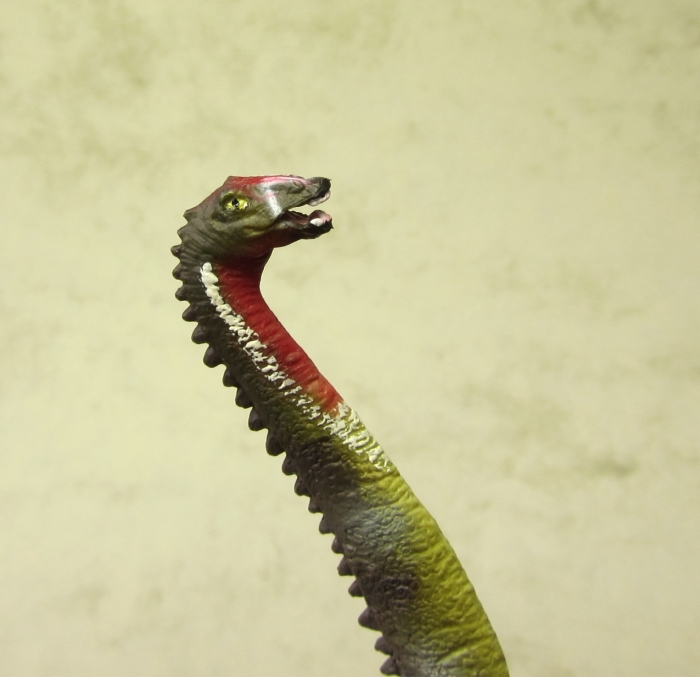
Another similarly common trait is that of the far too large scales. I’ve described them as being too ’tile-like’ hitherto, and it is true that ColectA have improved in this regard in their recent offerings, but I can’t quite warm to the kind of scales in areas such as the flanks. Still, they are preferable to elephantine skin at least, I suppose.
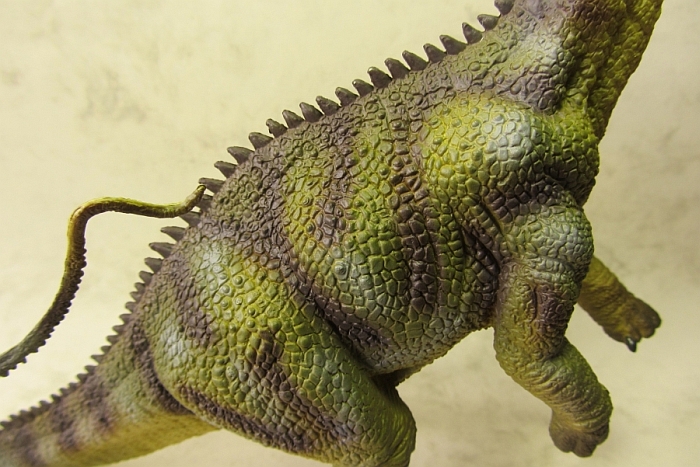
The most egregious flaw in this model must be the neck. It looks, as I said before, highly respectable in profile, but as to its width…
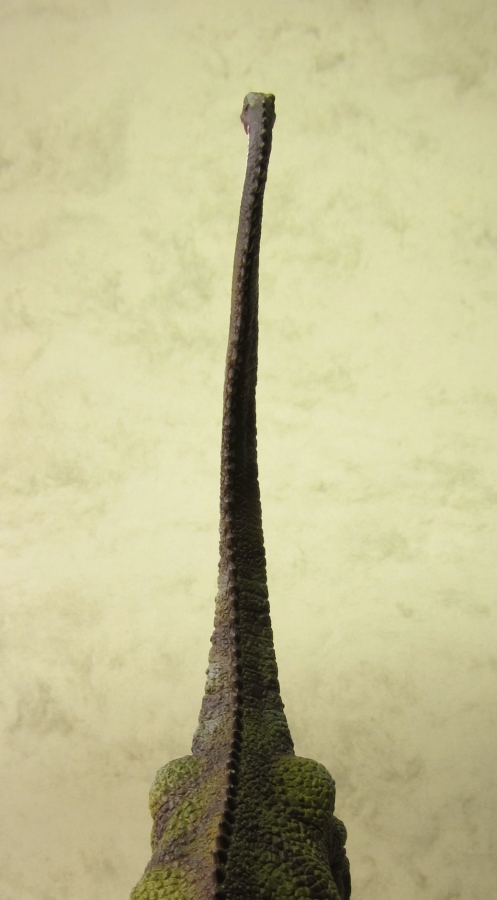
It is, alas, as thin as threadpaper. Having got over the feet hurdles (mostly), it seems the neck still leaves much to be desired (figuratively and literally), not in this figure alone but in some of the prevailing artwork. Sauropods have far thicker necks than the skeletons might suggest, ladies and gentlemen.
Overall, however, it is a very commendable figure, and one which I find myself growing fonder of. It’s certainly indicative of CollectA’s finer recent output, and that itself is very comforting indeed.
Disclaimer: links to Ebay and Amazon on the DinoToyBlog are affiliate links, so we make a small commission if you use them. Thanks for supporting us!




[…] ok. There is certainly better Diplodocus out there such as the 2008 Carnegie, of even the standing CollectA version. The colorization bothers me just because it reminds me of the original paint job for the […]
I like my old Battat Diplodocus better.
[…] green with a pale yellow underbelly, dark brown stripes, dark green feet, and black eyes. Like its larger version, it is rearing up on its hind limbs, seeing off a carnosaur or reaching for the most succulent […]
[…] of its mouth. The neck is rather robust and certainly a lot thicker than CollectA’s standing diplodocus. The head and neck is listing lazily towards its left side with osteoderms covering the top half, […]
Does someone know when is the Deluxe Parasaurolophus ,the Pachycephalosaurus ,the Daspletosaurus a d the repainted ankylosaurus available in the market.Please answer.Thanks.
Juan Andrés
Sim: the hands (or forefeet, if you will) are concave and horseshoe-shaped, whilst the hind feet simply have a flat, fleshy cushioning. In this aspect (and only this), they were not unlike that of elephant feet. I’ve just had a quick look at my CollectA Argentinosaurus, and yes, it has those sunken inner pads too. Odd…
That’s what I thought sauropod feet were like. What I meant was, sauropod feet didn’t have sunken inner pads, did they?
Heinrich: thank you!
I wonder why CollectA is making their sauropods have the center of their feet sunken in? I think I’ve seen it on their Alamosaurus and Ampelosaurus too. Sauropod feet weren’t like that, were they?
Coincido con todos los comentarios es una figura casi perfecta si exceptuamos el cuello y la cabeza. Collecta magistralmente está luchando de forma titánica y mejorando año tras año para colocarse entre los mejores del mercado de juguete, y eso que es una empresa muy joven. Por otra parte un Diplodocus Deluxe en posición erecta entiendo que incluso mejoraría al entrañable Jobaria panzudo de la misma colección.
Felicito nuevamente a Collecta por el esfuerzo que están realizando en mejorar la calidad de sus últimas creaciones.Me parece una figura impresionante,tanto por la pose (muy dinámica y elegante),como por el color.Coincido en el pequeño defecto de la expresión de la cabeza,pero al menos no se parece al Agustinia. Si lo hubieran hecho a escala 1:40 sería perfecto. Bien por Collecta !.
Diplodocids were very likely quite good at rearing!
Mallison, H. (2011). Rearing Giants – kinetic-dynamic modeling of sauropod bipedal and tripodal poses, pp. 237-250. In Klein, N., Remes, K., Gee, C. & Sander M. (eds.): Biology of the Sauropod Dinosaurs: Understanding the life of giants. Life of the Past (series ed. Farlow, J.), Indiana University Press
For me it’s an AWESOME model.The pose,the elegant sharped tail…a wonder.The unic problem I find is the too slender neck.It’s one of my most anticipated figures for 2013.I love the Carnegie 2008 model,but for me,this is more atractive .I value it 5 stars.